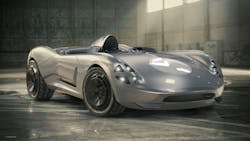Custom cars, especially of the hotrod and racing varieties, have long been a showcase for industrial automation technologies. We’ve reported on several automation-inspired innovations in this area over the past few years, ranging from the remote controlled “Psycho” to McLaren Racing’s Formula 1 team.
The recent announcement of the partnership between Hackrod and Siemens PLM Software represents something different. Rather than a specific application of automation technologies to create a specific product, the Siemens/Hackrod partnership is designed to showcase the coming democratization of engineering and manufacturing. As Siemens and Hackrod put it, this is “where the consumer becomes the creator.”
To illustrate this concept, Hackrod is creating ‘La Bandita’, which it says will be the world’s first car designed in virtual reality, engineered with artificial intelligence and 3D printed in structural alloy. La Bandita will serve as a proof of concept for a new industrial design-to-production methodology where individuals, start-ups and small enterprises can create the product of their needs or dreams as easily as playing a video game.
“We’re building an entirely new business to enable this,” said Mouse McCoy, CEO and co-founder of Hackrod. “We’re clean-sheeting a distributed manufacturing network. Even our headquarter operations are distributed across California, Colorado and Pennsylvania.”
At the Siemens Industry Analyst Conference 2018 in Boston, McCoy and Slade Gardner, Hackrod’s chief technology officer, explained how a variety of automation tools from Siemens, including its NX software, cloud-based collaboration Solid Edge Portal software, LMS Testing Solutions and Sinumerik CNC controls are all critical to the vision of this startup business and the construction of the company's own dual deposition and CNC machining platform, developed by Gardner.
“The Hackrod and Siemens partnership is vitally important because the Hackrod vision requires rapid data collection for product design and iteration,” said Gardner. "Siemens’ hardware connectivity for industrial IoT and multi-axis additive manufacturing are critical to the success of our customized manufacturing processes and our ability to develop sophisticated mechatronic systems. The products of our partnership will illustrate the impact that an efficient and motivated team can have with access to world-class digital design, engineering, visualization, manufacturing and inspection power.”
To better understand this partnership between Hackrod and Siemens, it helps to go back a couple of years to when Hackrod began constructing basic cars with reclaimed parts, outfitting them with off-the-shelf sensors, and then testing them under adverse conditions. During these tests, the sensors collected a number of critical data points.
“Most design knowledge in racing is wizardry” said McCoy. “It’s passed down from one person to the next and never quantified. So we started with known geometries [to develop a test car] and used the sensors to gather force loads to begin collecting data sets. We then gave those data to generative design software [Siemens PLM’s NX] and artificial intelligence to improve upon.” He added that Siemens MindSphere is serving as the artificial intelligence backbone for the additive manufacturing platform developed by Hackrod.
Gardner pointed out that simulation of the development process and construction of a car’s chassis is the first step in understanding its optimization. “We're using simulation to train machine learning to create optimized structures for the manufacturing process,” he said. “No one else is doing this right now. Of course, others use it to make adjustments for known defects, but the product itself is not being optimized to make the best use of additive manufacturing capabilities.”
“This is especially true on the larger scale of printing an entire car chassis and body,” said McCoy. Optimizing for production is critical when it comes to putting down pounds of material per hour rather than grams per hour, as is typical with most parts made with additive manufacturing.
The additive manufacturing platform, developed by Gardner and controlled by a Siemens Sinumeric 840D, prints both polymer via an extrusion-based technology and metal (aluminum) using a wire arc additive technique. Both of these processes are coupled with 5-axis CNC machining and all are located on the platform’s Z pillar.
The additive head extends to the work surface, deposits material and then retracts to allow the 5-axis spindle to do the machining. The CNC machining spindle has 10 position tool changes that allow it to use an end mill, block cutter, ball mill or lollipop cutter to achieve a wide variety of machining options.
While the aluminum printing that most companies currently undertake is small, the scale at which Hackrod is printing is 12-ft x 6-ft x 4-ft, said McCoy,
Hackrod also uses virtual reality (VR) from Nvidia technology for design review, along with gaming engines in the VR environment. “Other businesses are still building full-scale clay models for design reviews," McCoy said. "But we’re doing it in completely in VR.”
Gardner added, “The process we’ve developed is bigger, faster and more flexible and accessible than current 3D printing technology on the market and it solves the main challenges of 3D metal printing—dimensional tolerance, scale and scalability, and surface finish.”
3D printing will produce La Bandita’s chassis, body and frame supports. Other parts will be sourced externally from suppliers—with a heavy focus on the re-use of existing parts—and then connected to the overall product design using Siemens PLM generative engineering.
Hackrod’s use of recycled parts is something McCoy expects to be a key aspect of future customer designs using the company's technology. “Our users may consider scrapyards as accessible inventory for components and see the junkyard as an opportunity ground from which to the build car of their dreams,” he said.
McCoy explained that when Hackrod’s technology becomes available, customers will use it either to spec components they have already obtained from junkyards or elsewhere or to purchase parts online. The parameters of those components will then aid in designing the car with generative engineering. For example, if you choose a heavy engine for the car, the design software will direct you to add more weight to the rear of the car to support that engine. McCoy stressed that the interactive software environment Hackrod is creating with Siemens will be “like playing a video game” with no complex coding required.
Hackrod expects to complete this project in late 2018 or early 2019. After printing the full-scale chassis and body, Siemens LMS Testing Solutions will be used to close the loop and compare the virtual product with the real one, said McCoy. “We’ll be using Siemens PLC7 for control of assembly and then start working with Siemens’ TASS International for safety and crash testing,” he added.
At its core, the ethos and inspiration for Hackrod was the American hotrod, whose first creators were young men returning from WWII with “skills forged by the war machine," McCoy said, adding, "They were the original vehicle hackers. We’re taking the next step by integrating this idea with digitalization.”
He stressed that, although Hackrod is clearly focused on cars, this idea “isn’t just about cars; it’s about being able to create whatever you want as you want it. That thought underscores Siemens' big picture perspective of the growing connectedness of systems via Industry 4.0 and the Industrial Internet of Things, and the democratizing of engineering and manufacturing through advances in software that require little or no coding expertise.
As these capabilities get fleshed out, McCoy said he sees this as being potentially very disruptive to the motorcycle business. “Customized bike manufacturers today typically make one motorcycle a month, but many of them don't work with CAD software—it’s all done by hand drawing. But if you scan an existing motorcycle and make a digital twin of it, you could then scale the manufacturing of it. That could turn a motorcycle builder into a motorcycle manufacturer overnight.”
Leaders relevant to this article:


